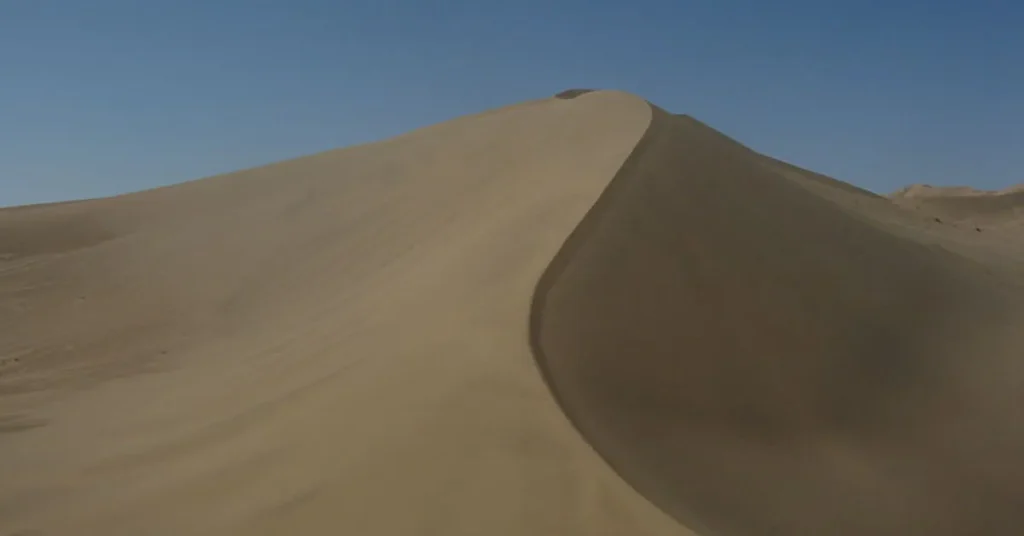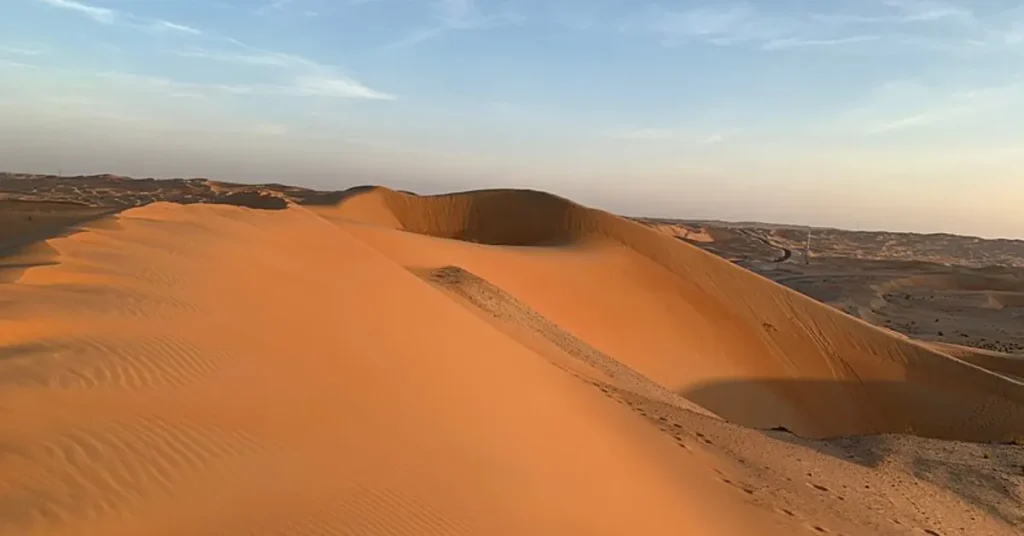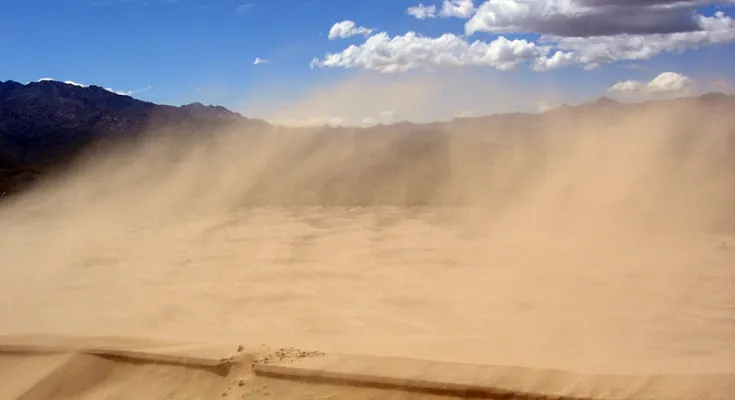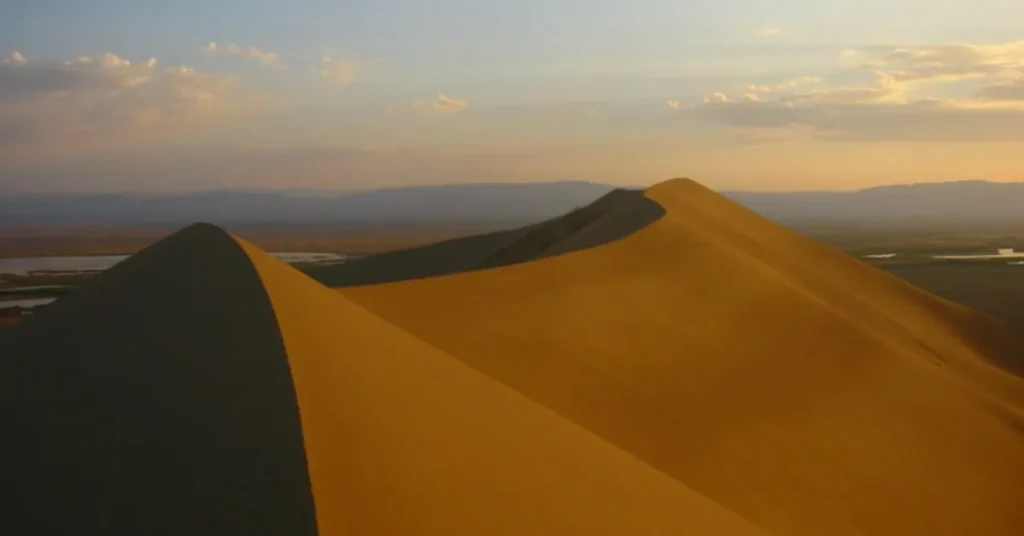Have you ever heard that dunes can sing? Yeah, you heard that right. These special sand dunes can make a deep, groaning sound when wind or people disturb them. And this sound can travel for miles. Imagine suddenly walking in the desert and hearing a horrifying sound, but there is nothing around you, and it keeps going. You would start to believe in ghosts for a second there. But what is behind this eerie phenomenon? How does it change from one place to another? We will answer these questions and more in this article.
Table of Contents
Singing dunes: The desert’s natural orchestra

“Desert spirits can do incredible things. Even in the daytime, you can sometimes hear their voices or the sound of weapons, drums, or different musical instruments. That is why many travelers stay close to each other.” This is how Marco Polo described singing dunes.
Around 20% of the Earth is covered by deserts, and many have dunes. Sand dunes are formed when wind piles up sand on a large scale. These dunes have different kinds of shapes. So, who is singing in these dunes? Some sand dunes make a special low-frequency noise. People call it ‘singing,’ ‘humming,’ or ‘booming.’ It is like they are playing their own desert symphony!
These sounds are so deep and melodic that they resemble a cello’s notes or an aircraft’s droning sound. They can last up to 15 minutes and be heard up to 6.2 miles (10 kilometers) away. The Spontaneous Acoustic Emission from Granular Shear Flow paper explains the sustained low-frequency sound of sand dunes.
But it is not easy to catch the melody of a dune. It is like finding a hidden treasure in the sand. These sounds do not happen all the time. Some dunes, when they decide to sing, can make sounds over 105 decibels. It is louder than a motorcycle, a rock concert, a car horn, or a lawn mower. You can find these singing sand dunes in about 35 desert locations around the world. Booming Sand Dunes paper discusses the remarkable capacity of booming sand dunes to produce sounds comparable with those from a stringed instrument.
Spooky sands through history
People have heard of these dunes for centuries, and it can get scary when you do not understand something! So, they built many cultural interpretations and beliefs around it. As we mentioned earlier, the Venetian explorer Marco Polo heard these eerie dune sounds while traveling in the Gobi Desert. He thought desert sands were haunted by evil spirits making musical sounds.
The Bedouin tribes in the Middle East had different beliefs. They thought the strange sounds were divine communication. They had a strong connection with the desert, so they thought it was the voice of God or an angry djinn.
Some Native American tribes believed these dunes were special and spiritual. The weird sounds were like the dunes themselves speaking. Some tribes even avoided them out of respect.
How do singing sand dunes work?
During an avalanche, the sand grains move against each other. This movement makes energy, like the bows of a violin. At the same time, the waveguide changes the sound. It stops the sound waves from leaving and makes them louder through internal reflection. Finally, the dune has a solid layer that reflects the sound waves and stops them from spreading out. Because of this, the sound gets very loud in the sand and then moves into the air as a song.
When do singing sands sing?
All sand dunes do not make good sounds. They need certain conditions to do so.
- First, the sand must be very dry. It is a piece of cake in a desert, right? But if there is even a little moisture or humidity in the sand, it can stop the dunes from making sounds.
- The sand particles also need to be the same size. The average diameter should be 200 micrometers. The wind steps in here and lifts particles within a certain size range.
- The size and texture also change the sound of the desert. Specifically, the sand particles need to be spherical and smooth. That is why booming is mostly heard in dunes with a lot of quartz.
There are other theories about how singing sand dunes form and make desert music.
- The Resonance Theory – This theory says that the resonance makes the sound of singing sand dunes of the dune itself. When the wind blows over the dune, it creates a vibration that resonates through the sand particles and makes a sound.
- The Friction Theory – According to this theory, the sound of singing sand dunes is made by the friction between the sand grains as they move against each other. This friction creates a vibration that makes a sound.
- The Electrostatic Theory – Some scientists think that the sound of singing sand dunes is made by electrostatic charges that build up on the surface of the sand particles. When the charges are released, they make a sound that is made louder by the dune itself.
Why are singing sand dunes important?

Singing sand dunes may not have a direct practical use like other natural resources, but they are important in several ways.
Scientific curiosity
Singing sand dunes is more than just a weird desert noise! They are like a treasure chest for scientists. These strange sounds help them learn about the environment, the area’s history, and even how different materials interact. Research on the sound mechanics of squeaky sand shows that the noise comes from a narrow zone beneath the pressure, where sand grains experience friction as they move slightly.
Stories in the sand
These dunes have been around for ages, and different cultures have woven them into their stories. They have been seen as voices of gods, places of magic, and even sources of inspiration for artists and musicians.
Environmental awareness
Studying singing sand dunes can help us understand the balance of desert ecosystems better and how things like wind patterns and human activities can affect it.
A natural wonder for everyone
These singing dunes are like a natural attraction! Their unique sound draws in tourists and nature lovers.
Inspiration and wonder
The biggest takeaway from singing sand dunes is that they spark curiosity and remind us to appreciate the beauty and wonder of the world around us. They are like a reminder to stop, listen, and be amazed by the unexpected things nature can create.
Conclusion
Singing sand dunes are one of the world’s most amazing and mysterious natural phenomena. In this article, we discussed how wind, sand, and sound make this mysterious phenomenon. Although they are not practically useful, they have been a point of curiosity, captivating scientists, artists, and tribes for centuries. They remind us about the harmony and creativity of nature.

